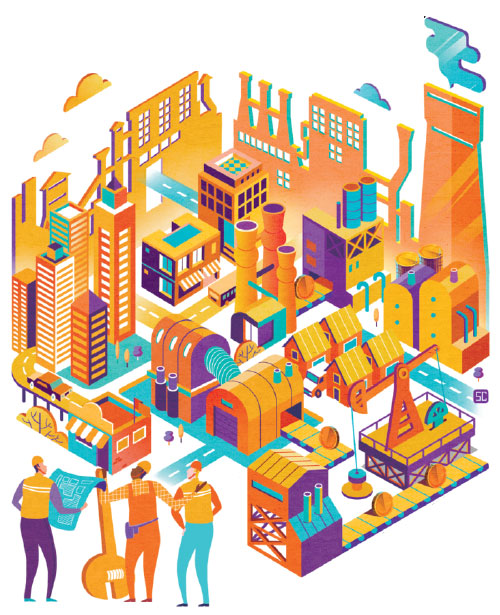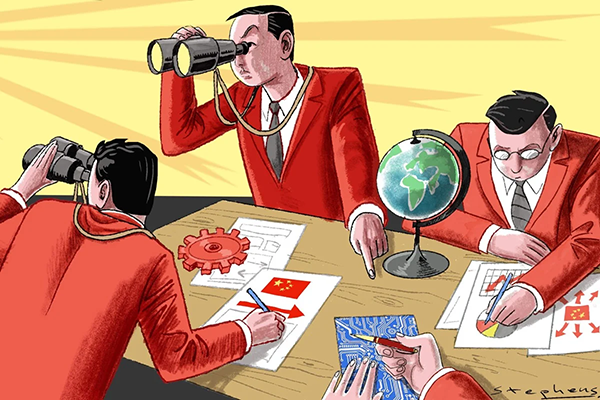Wang Huiyao: Better global governance through infrastructure
July 01 , 2019
By Wang Huiyao |
President of the Center for China and Globalization(CCG)
The Belt and Road Initiative continues to create new opportunities for global multilateral cooperation and world economic development
The need for strengthened global governance is more apparent than ever.
Since World War II, global institutions such as the United Nations and multilateral trade and finance institutions such as the World Bank, the International Monetary Fund, and the World Trade Organization have done much to mitigate conflict and promote peace and development.
However, in the age of Industrialization 4.0, globalization has entered a new era. The world now faces a myriad challenges: the global economy is slowing down, global governance is in urgent need of reform, and unilateralism is on the rise.
Under these circumstances, the Belt and Road Initiative, emerging as a new plan for global governance and win-win cooperation, has become an important platform and made major contributions to global infrastructure development and investment.
According to the latest report by the World Bank, completed and planned transportation projects under the Belt and Road Initiative are estimated to reduce the transit time of goods by 1.7 to 3.2 percent and cut shipping times worldwide by 1.2 to 2.5 percent. The World Bank also projects that Belt and Road infrastructure projects will raise income levels by 1.2 to 3.4 percent in member countries and regions and 0.7 to 2.9 percent worldwide.
By complementing and strengthening preexisting global governance mechanisms, the Belt and Road Initiative has become a catalyst for cross-border cooperation. By harnessing the new growth engine of infrastructure development, the Belt and Road Initiative promises to bring more opportunities for global multilateral cooperation and world economic development.
Countries participating in the Belt and Road Initiative are at various levels of development. Many face challenges and gaps in terms of infrastructure, capacity to develop resources, governance, and the supply of skilled labor.
Experts estimate that global demand for infrastructure through 2040 will reach $9.4 trillion. It is expected that even one-fifth of this financing will be difficult, if not impossible.
This infrastructure investment gap heralds great opportunities for the Belt and Road Initiative. The initiative can also support the growth of enterprises and help emerging economies to upgrade industry and specialize, while nurturing innovation and regional integration.
To fulfill this promise, the real challenges facing the Belt and Road Initiative need to be recognized, and its aims and benefits better communicated to overcome misunderstandings that persist in some Western nations. This calls for the Belt and Road Initiative to take a more multilateral approach to attract more countries to join. This shift is in line with core Belt and Road Initiative concepts of multilateralism, transparency and openness.
To fully realize the multilateral nature of the Belt and Road Initiative, the following five key directions are proposed.
First, a Belt and Road Initiative International Cooperation Committee could be created to facilitate the Belt and Road Initiative’s transition from a bilateral to more multilateral approach. This committee would be comprised of a selection of representatives from key international organizations. Embedding a broad spectrum of experience and perspectives into the Belt and Road Initiative advisory apparatus would enhance its multilateral nature and help to address concerns about it being too Sino-centric.
Second, the Belt and Road Initiative can deepen engagement with international organizations. Twenty-nine have already signed Belt and Road Initiative memorandums of understanding. In particular, the Asian Infrastructure Investment Bank has made substantial progress and can be used as a template for further multilaterization of the Belt and Road Initiative.
The Belt and Road Initiative can also draw expertise and resources by working closely with established institutions such as the World Bank, IMF, Inter-American Development Bank, African Development Bank, and European Bank for Reconstruction and Development. Closer cooperation with the UN could also boost the Belt and Road Initiative’s role in global governance.
In addition, the Belt and Road Initiative could participate in the Paris Club, an informal grouping of nations and institutions that work to find coordinated and sustainable solutions to payment difficulties experienced by debtor nations. This would help to avoid undue stress on the public finances of participating countries and address false claims that the Belt and Road Initiative is creating “debt traps” for developing countries.
Third, the role of the Belt and Road Initiative as a project for global economic revitalization should be clarified and more strongly emphasized. This framing will help to emphasize the development-oriented nature of the Belt and Road Initiative and dispel geopolitical misunderstandings. As a global development project, the Belt and Road Initiative should encourage the participation of the United States, the European Union, Japan, and Republic of Korea, as there is huge scope for infrastructure investment cooperation with developed countries. For example, the United States has an infrastructure investment gap estimated at around $ 3.8 trillion.
Fourth, working through the Belt and Road Initiative, China can contribute in various aspects such as helping to develop global governance and establishing new models of regional governance based on cooperation in financing, infrastructure, industrial capacity, talent and migration.
Last but not least, social actors such as think tanks can play a crucial role in bridging the gap between countries through people-to-people interaction, while also helping to shape standards for the Belt and Road Initiative and uphold protection for the environment and labor rights.
By following the directions laid out above – multilateralism, cooperation with international organizations, emphasizing the Belt and Road Initiative’s role as a development project, and building new modes of global governance – the Belt and Road Initiative can fulfill its promise as an engine for the reform of global infrastructure. Doing so will uphold the initiative’s golden principles of extensive consultation, joint contribution and shared benefits, promoting global governance in trade, finance, technology and people-to-people engagement.

Dr. Wang Huiyao is president of the Center for China and Globalization, the largest independent think tank in China, with over 100 researchers and members of staff.
Topical News See more






